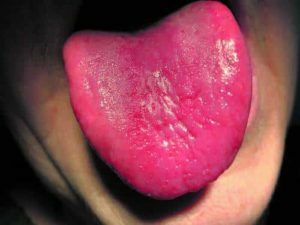 Health and hygiene of the oral cavity is very important because any dental problems can have extremely serious consequences for the whole organism.
Health and hygiene of the oral cavity is very important because any dental problems can have extremely serious consequences for the whole organism.
Do not overlook such an important organ as language. His health is as important as the health of the teeth themselves.
Contents
- What language should
- do How to inspect
- Why did the language change color?
- Raspberry tongue in an adult
- Causes of a red tongue in an adult
- Causes of a pale pink color
- Disease causing a discolouration
- Causes of a discoloration of a child's tongue
- Raspberry tongue
- Causes of a red tongue in a child
- Pale pink
- Diseases that cause discolourationlanguage in the child
- Color change after antibiotics
- What to do if a symptom is found
- Which medical doctor to consult
- Diagnosis language
- Treatment features
- Complicationsand consequences
- Prevention
What language
should be Absolutely healthy language usually has a pink color, not too bright. On its surface, the taste buds are clearly visible, white coating may be present. Its presence is considered an absolute norm and is not the cause for panic.
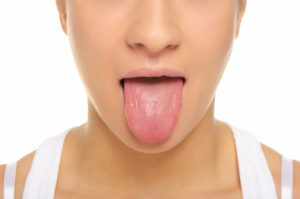
Language is a muscular organ, in the middle of which there is a fold, it must also be viewed by a healthy person. When moving, there should be no discomfort and painful sensations. Only in this case the body can be considered absolutely healthy. Deviation from the norm indicates the presence of the disease, which can only be determined by a specialist.
How to inspect
If you notice a discoloration or discomfort in the oral cavity, then a primary examination can be done on your own.
It is desirable to observe several conditions when examining:
- should be performed in the morning, on an empty stomach;
- should be rinsed with water before examination;
- is best viewed in front of a window or a bright light source.

In order to assess the condition of the oral cavity, you need to open your mouth wide and say a lingering sound "A" or "E".Any noticed change or a deviation from a habitual condition should become an occasion to address to the qualified expert for finding-out of the reasons and purpose or appointment of corresponding or meeting treatment.
Why did the language change color?
"Raspberry tongue" is not just a description of the color of the muscular organ, it is an existing medical term. The reasons for which it is painted in a brighter color, there may be several and they are not always dangerous to health. However, this may be an indicator of the presence of a sufficiently serious disease, which requires urgent diagnosis and treatment.
Raspberry tongue in an adult
Do not forget that the discoloration can be triggered by the use of strongly coloring products, such as beets. Therefore, before you sound the alarm, remember what you ate today for dinner. If the diet did not have similar products, the causes of redness may be as follows:
- liver disease;

- Hunters' glossitis - pathological inflammation of the mucosa;
- angina - fever and inflammation;
- problems with the gastrointestinal tract.
The last item can manifest itself in different ways. A new growth of another color may appear on the surface, a plaque may be observed at the edges. Or vice versa, only the tip of the muscle will be painted in a different color. A competent specialist does not in vain begin examining patients precisely from the oral cavity, the location and nature of the spots can tell a lot about the nature of the disease.
Causes of a red tongue in an adult
The appearance of a red shade is most often triggered by inflammation of the taste buds. Redness of the receptors can be caused by thermal causes - consumption of too hot or cold food.
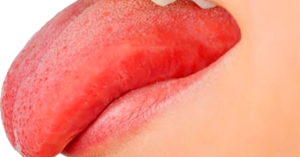
As a cause of redness, a chemical burn is released, which is also possible as a result of vomiting, as in this case the gastric juice that has strong chemical properties enters the oral cavity.
Mechanical injury can also cause redness. The muscle can be injured with a toothbrush, utensils, candy, after all, just bite it leads to inflammation and redness.
Any inflammatory processes in the body that were caused by a virus or infection can also be reflected on the surface of the tongue.
Causes of pale pink color
If a darker color indicates inflammation, then the pallor of this muscle organ most often reports anemia - a violation of hemoglobin. This shade can also appear with beriberi, malnutrition and a sharp decrease in weight. Almost always this problem can be solved with a balanced diet.
Disease causing color change
First of all, it is necessary to understand the reasons for this change. There can be several.
The most common, in addition to those described above, are the following:
- a number of infectious diseases;
- scarlet fever;
- pneumonia;
- inflammation in the stomach - gastritis;
- severe poisoning degree;
- kidney failure;
- lack of vitamin B 12.
Reasons for changing the color of the tongue in a child
In children, sensitivity to various foods is usually higher than that of adults, so it is worth checking whether the tongue is simply stained from the eaten food. To do this, give the child water or a slice of bread, in the case of staining, the intensity of the color will decrease.
Raspberry tongue
Raspberry color can signal serious childhood illnesses. One of the most common is scarlet fever. The surface of the tongue not only acquires a bright crimson color, but it also becomes smooth and shiny, and the taste buds are almost invisible. Confirms the diagnosis of a small rash all over the body and fever.
Kawasaki disease is less common in children, it affects children under 5 years old. With her tongue the child becomes very brightly crimson and covered with pimples. In this case, even hospitalization may be required, since this syndrome is extremely dangerous. Some symptoms are similar to those of measles and scarlet fever. An additional symptom that will help diagnose Kawasaki's disease becomes conjunctivitis, which affects the patient during the first week.
Causes of a red tongue in a child
Redness is usually caused by the same reasons as in adults, that is, chemical and mechanical damage. They occur in children more often, because at an early age there is a change of teeth, the formation of an occlusion, which can injure the muscle. Also, kids are often injured by too solid food, cutlery or toys.
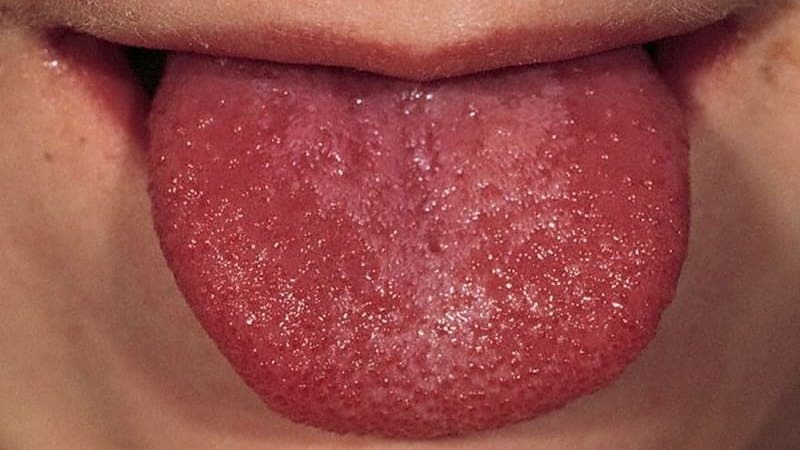
A growing organism may develop an allergic reaction to certain products or oral hygiene products.
Pale pink tongue
Pallor speaks of exhaustion of the body, vitamin deficiency or anemia. You should take blood tests and appoint a diet rich in vitamins. Reducing the intensity of color also indicates a violation of the GI tract, in this case the muscle will have a slightly grayish tinge.
Diseases provoking a discoloration of the tongue in a child
Scarlet fever and Kawasaki disease are very dangerous diseases that usually require hospitalization. However, the symptom may manifest itself for other reasons:
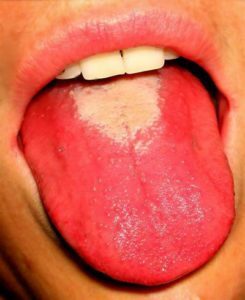
- angina;
- influenza;
- measles;
- chickenpox;
- pneumonia.
These diseases are not less serious and also require immediate medical intervention.
Sometimes the raspberry tongue is seen in infants with digestive system diseases. Similar symptoms should be addressed to a pediatrician.
Color change after antibiotics
Everyone knows that such drugs as antibiotics strongly affect many internal systems of the body. Very often the damage is indicated by the surface of the tongue. After taking antibiotics, the patient can observe red spots on the sides and in the center.
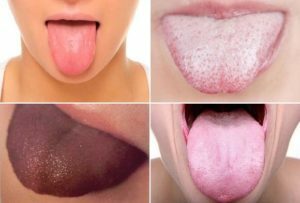 Causes may be different, since similar drugs, especially those that the patient took without prescribing a doctor, seriously damage internal organs. In addition, the patient may be allergic to any of the components of the drug.
Causes may be different, since similar drugs, especially those that the patient took without prescribing a doctor, seriously damage internal organs. In addition, the patient may be allergic to any of the components of the drug.
What to do with this only the specialist will tell. First of all, it is necessary to stop taking medications or replace them with another drug, antiallergens are also often prescribed.
In medicine, it has been repeatedly observed that the language almost immediately reflects all the damage to the internal organs. In the case of antibiotics, a large red spot appears in the center of the muscle. It signals a stomach damage, which can have very unpleasant consequences.
What to do if a symptom of
is found. In this case, the nature of the lesion should be determined. If it is mechanical, then do not worry, if only the damage is small. The same is the case with a burn, thermal or chemical.
In the case when the color has changed due to such frivolous, at first glance, illnesses like influenza, angina or allergies, you should not let the condition run its course. Medical intervention will not be superfluous. Especially when it comes to the child.
To which doctor to contact
When the color of the tongue causes doubts and obvious discomfort and it is not clear what caused the change, it is necessary to immediately go to the local therapist or pediatrician to find out the reasons.
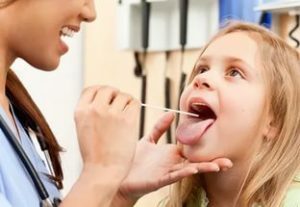 A doctor who can certainly diagnose you - an otolaryngologist, in the people "ear-voice-nose".It is he who examines the oral cavity and upper respiratory tract, then either determines the cause, or sends it to another specialist, depending on the nature of the disease.
A doctor who can certainly diagnose you - an otolaryngologist, in the people "ear-voice-nose".It is he who examines the oral cavity and upper respiratory tract, then either determines the cause, or sends it to another specialist, depending on the nature of the disease.
In case the inflammation is caused by oral diseases, such as caries, stomatitis or periodontitis, the ENT will be directed to the dentist. And if the inflammation is caused by disturbances in the endocrine system, the patient will receive a referral to the endocrinologist.
Diagnosis of
Any diagnosis will be based on the study of symptoms and anamnesis. Analyzes, which in this case are necessary - is the study of the composition of microflora on the affected area of the muscle or a blood test that allows to identify or exclude the anemia and allergic nature of the disease.
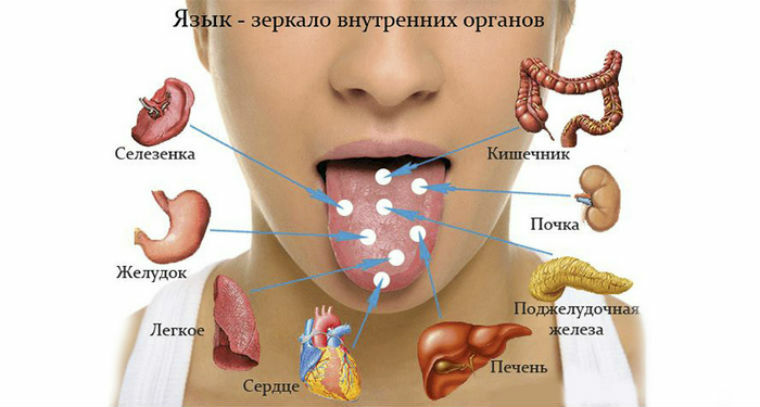
Features of treatment
Raspberry tongue is most often not a disease, but a symptom, so you need to treat the cause of the disease. In such situations, complex treatment is prescribed, which includes the exclusion of drugs that can cause allergic reactions, a balanced diet, mouth rinsing with an antiseptic, such as Furacilin or Chlorhexidine, and rinsing with herbal decoction.
If the patient has pain or discomfort, oral rinsing with an anesthetic is also prescribed.
In complicated and neglected cases, even surgical intervention may be required to remove damaged tissue. Antibiotics are used to restore the body.
Complications and consequences of
It is very important to pay attention to such a symptom in time, as complications can be serious enough, and the consequences even lethal. For example, Kawasaki's disease provokes a heart attack and without medical intervention this syndrome can be fatal in just a few weeks.
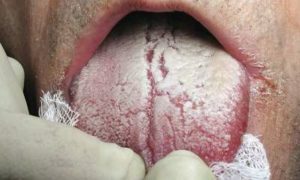
A very frequent complication is candidal stomatitis( pictured left), the bacteria of which actively multiply in inflamed and damaged tissues.
Any disease in a neglected stage can cause a violation of pronunciation, bite, teeth dislocation and sleep disturbances.
Since changing the color of the tongue is often only a symptom of another disease, complications can also be very diverse.
Prophylaxis of
Prevention of any disease is divided into primary and secondary. In the primary, that is, before the onset of symptoms include:
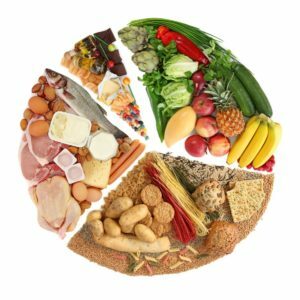
- refusal from smoking and alcohol;
- thorough oral hygiene;
- is a healthy, balanced diet.
Secondary prevention consists in a timely visit to the attending physician, compliance with all of its recommendations, as well as rinsing the oral cavity with antiseptic agents immediately after the inflammation is detected.
Oral health is very important. It can tell a lot about the general condition of the body. Therefore, do not self-medicate and use unproven drugs that were not prescribed by the doctor. At the first symptoms, which seem suspicious, you should seek qualified help. This question is especially acute when it comes to the child.
